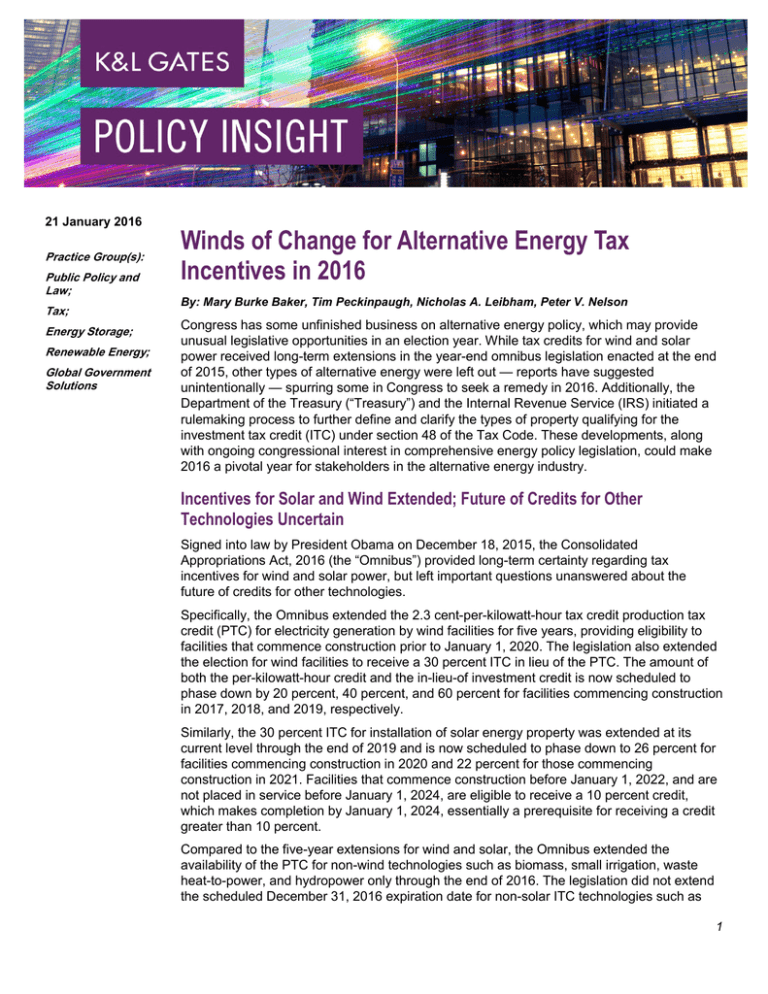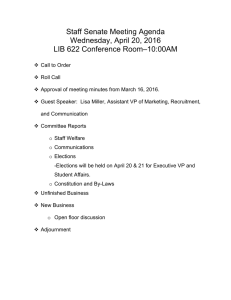Winds of Change for Alternative Energy Tax Incentives in 2016
advertisement

21 January 2016 Practice Group(s): Public Policy and Law; Tax; Energy Storage; Renewable Energy; Global Government Solutions Winds of Change for Alternative Energy Tax Incentives in 2016 By: Mary Burke Baker, Tim Peckinpaugh, Nicholas A. Leibham, Peter V. Nelson Congress has some unfinished business on alternative energy policy, which may provide unusual legislative opportunities in an election year. While tax credits for wind and solar power received long-term extensions in the year-end omnibus legislation enacted at the end of 2015, other types of alternative energy were left out — reports have suggested unintentionally — spurring some in Congress to seek a remedy in 2016. Additionally, the Department of the Treasury (“Treasury”) and the Internal Revenue Service (IRS) initiated a rulemaking process to further define and clarify the types of property qualifying for the investment tax credit (ITC) under section 48 of the Tax Code. These developments, along with ongoing congressional interest in comprehensive energy policy legislation, could make 2016 a pivotal year for stakeholders in the alternative energy industry. Incentives for Solar and Wind Extended; Future of Credits for Other Technologies Uncertain Signed into law by President Obama on December 18, 2015, the Consolidated Appropriations Act, 2016 (the “Omnibus”) provided long-term certainty regarding tax incentives for wind and solar power, but left important questions unanswered about the future of credits for other technologies. Specifically, the Omnibus extended the 2.3 cent-per-kilowatt-hour tax credit production tax credit (PTC) for electricity generation by wind facilities for five years, providing eligibility to facilities that commence construction prior to January 1, 2020. The legislation also extended the election for wind facilities to receive a 30 percent ITC in lieu of the PTC. The amount of both the per-kilowatt-hour credit and the in-lieu-of investment credit is now scheduled to phase down by 20 percent, 40 percent, and 60 percent for facilities commencing construction in 2017, 2018, and 2019, respectively. Similarly, the 30 percent ITC for installation of solar energy property was extended at its current level through the end of 2019 and is now scheduled to phase down to 26 percent for facilities commencing construction in 2020 and 22 percent for those commencing construction in 2021. Facilities that commence construction before January 1, 2022, and are not placed in service before January 1, 2024, are eligible to receive a 10 percent credit, which makes completion by January 1, 2024, essentially a prerequisite for receiving a credit greater than 10 percent. Compared to the five-year extensions for wind and solar, the Omnibus extended the availability of the PTC for non-wind technologies such as biomass, small irrigation, waste heat-to-power, and hydropower only through the end of 2016. The legislation did not extend the scheduled December 31, 2016 expiration date for non-solar ITC technologies such as 1 Winds of Change for Alternative Energy Tax Incentives in 2016 fuel cells, combined heat and power systems, small wind projects, or geothermal heat pumps. As a result, under current law, incentives for these technologies will expire at the end of 2016, while the credits for wind and solar will remain in place as outlined above. Members of congressional leadership have said that the disparate treatment within the Omnibus may have been an oversight, and policymakers have signaled an early willingness to seek a fix; there is already discussion of extensions for non-wind technologies under section 45 of the Tax Code, the non-solar technologies under section 48, and possibly expanding tax credits to alternative energy technologies that are just now coming online or into the market place. This effort could grow to include other energy-related policies, such as reforming the statute governing master limited partnerships. Must-pass legislation could serve as a vehicle for these revisions of the energy credits this year. A robust energy policy bill (see discussion below) being pushed in both the House and Senate may also be a vehicle for adoption. IRS Seeks Input on ITC Definitions of Energy Property A separate and distinct issue from how long one might be eligible to claim an ITC under section 48 deals with the specification and clarification of the types of property that qualify for the credit. In Notice 2015-70, Treasury and the IRS announced their intent to issue regulations to further specify and define eligible solar, geothermal, fuel cell, microturbine, combined heat and power, wind energy, and ground or groundwater property. The rulemaking is timely, given that the regulations under section 48 have not been updated since 1987, and thus, do not address several types of property and technologies that have emerged in the intervening years that may be eligible for the credit. In addition, the Obama Administration is racing to finalize its regulatory agenda before leaving office at the end of the year and may view the section 48 rulemaking as a chance to leave its mark on energy tax policy. In advance of the rulemaking, the IRS is seeking comments from stakeholders on the facts, circumstances, and other issues it should take into account in the proposed regulations, particularly with respect to the following five topics: 1. Whether only property that actually produces electricity may be considered energy property or whether property such as storage devices and power-conditioning equipment may also be considered energy property. 2. Whether dual-use property should qualify for the credit and, if so, under what circumstances it should qualify. If it should qualify, what portion of the basis of dual-use property should be taken into account in computing the energy percentage. 3. Comprehensive definitions of the types of energy property eligible for the ITC under section 48. 4. Definitions of terms such as storage devices, power-conditioning equipment, transfer equipment, and other property commonly used in conjunction with energy property eligible for the ITC under section 48, as well as definitions of parts related to the functioning of these items. 5. The need for other energy-related definitions. The section 48 rulemaking provides a unique opportunity for energy industry stakeholders to influence the ITC eligibility of particular types of energy property. Industry participants whose 2 Winds of Change for Alternative Energy Tax Incentives in 2016 technologies were specified in the 1987 regulations — such as solar, wind, and geothermal — can update Treasury and the IRS about developments in those fields and the ways in which current practice diverges from the situations described in the current regulations. Others have the chance to help shape the regulations pertaining to their particular technologies that may not have existed when the current regulations were issued. The rulemaking is especially important to the developers of energy storage and other ancillary property, as these categories are not specified as explicitly in the Tax Code and may be subject to greater regulatory interpretation in the rulemaking process. This is a rare opportunity to weigh in with Treasury and the IRS on regulations that can have significant impact on a technology. It also offers the chance to address issues regarding section 48 outside of the legislative process. Comments are due by February 16, 2016. Technology-Neutral Reform Remains Under Consideration in Congress Tax policy may intersect with other congressional energy initiatives in the year ahead, particularly in the Senate. Senate Energy and Natural Resources Committee Chairwoman Lisa Murkowski (R-AK) is reportedly close to advancing her Energy Policy Modernization Act (S. 2012) to the Senate floor. While Sen. Murkowski’s bill does not have a tax title at present, it could present a vehicle for efforts to amend the PTC and ITC as discussed above, or make other changes to tax rules affecting the energy industry (e.g., master limited partnerships). Congress remains interested in proposals to reorient energy tax incentives away from the Tax Code’s current focus on specific technologies and toward a technology-neutral system that rewards technologies based on performance metrics. As an example, the draft energy policy bill released by Senate Energy and Natural Resources Committee Ranking Member Maria Cantwell (D-WA) in September 2015 provides the most recent exposition of such an approach, including a tax title that incorporated the technology-neutral proposal developed by former Senate Finance Committee Chairman Max Baucus (D-MT). While Sen. Cantwell’s bill is unlikely to pass through the Republican-controlled Congress, it indicates continuing interest among Senate Finance Committee staff in technology-neutral reform and the likely direction of energy tax policy should Democrats retain the White House and make gains in Congress in the 2016 elections. Authors: Mary Burke Baker Nicholas A. Leibham Government Affairs Advisor mary.baker@klgates.com +1.202.778.9223 Partner nick.leibham@klgates.com +1.202.778.9284 - Washington, D.C. +1.949.253.0900 - Orange County Tim Peckinpaugh Partner tim.peckinpaugh@klgates.com +1.202.661.6265 Peter V. Nelson Associate peter.nelson@klgates.com +1.202.778.9358 3 Winds of Change for Alternative Energy Tax Incentives in 2016 Anchorage Austin Fort Worth Frankfurt Orange County Beijing Berlin Harrisburg Palo Alto Paris Boston Hong Kong Perth Brisbane Houston Pittsburgh Brussels London Portland Charleston Los Angeles Raleigh Charlotte Melbourne Research Triangle Park Chicago Miami Dallas Milan San Francisco Doha Newark São Paulo Dubai New York Seattle Seoul Shanghai Singapore Sydney Taipei Tokyo Warsaw Washington, D.C. Wilmington K&L Gates comprises approximately 2,000 lawyers globally who practice in fully integrated offices located on five continents. The firm represents leading multinational corporations, growth and middle-market companies, capital markets participants and entrepreneurs in every major industry group as well as public sector entities, educational institutions, philanthropic organizations and individuals. For more information about K&L Gates or its locations, practices and registrations, visit www.klgates.com. This publication is for informational purposes and does not contain or convey legal advice. The information herein should not be used or relied upon in regard to any particular facts or circumstances without first consulting a lawyer. © 2016 K&L Gates LLP. All Rights Reserved. 4
